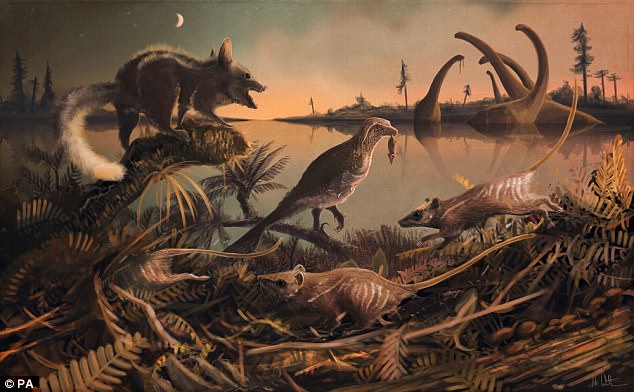Two teeth from a small, rat-like creatures, found on Dorset’s Jurassic Coast, England, are Man’s earliest ancestors.
They walked on earth 145 million-years-ago, in the shadow of the dinosaurs and consider to be the earliest undisputed fossils of ancestors to most mammals alive today, including creatures as diverse as the blue whale and the pigmy shrew, belonging to the line that led to human beings.
Will you offer us a hand? Every gift, regardless of size, fuels our future.
Your critical contribution enables us to maintain our independence from shareholders or wealthy owners, allowing us to keep up reporting without bias. It means we can continue to make Jewish Business News available to everyone.
You can support us for as little as $1 via PayPal at office@jewishbusinessnews.com.
Thank you.
The teeth were recovered from rocks exposed in cliffs near Swanage which has given up thousands of iconic fossils. Grant, now reading for his Master’s degree at The University of Portsmouth, said that he knew he was looking at something mammalian but didn’t realise he had discovered something quite so special. His supervisor, Dave Martill, Professor of Palaeobiology, confirmed that they were mammalian, but suggested Dr Sweetman, a mammal expert should see them.
The findings published in the Journal, Acta Palaeontologica Polonica, by Dr Steve Sweetman, Research Fellow at the University of Portsmouth, whose primary research interest concerns all the small vertebrates that lived with the dinosaurs, identified the teeth but it was University of Portsmouth undergraduate student, Grant Smith who made the discovery.
Dr Sweetman said: “Grant was sifting through small samples of earliest Cretaceous rocks collected on the coast of Dorset as part of his undergraduate dissertation project in the hope of finding some interesting remains. Quite unexpectedly he found not one but two quite remarkable teeth of a type never before seen from rocks of this age. I was asked to look at them and give an opinion and even at first glance my jaw dropped!”
“The teeth are of a type so highly evolved that I realized straight away I was looking at remains of Early Cretaceous mammals that more closely resembled those that lived during the latest Cretaceous – some 60 million years later in geological history. In the world of paleontology there has been a lot of debate around a specimen found in China, which is approximately 160 million years old. This was originally said to be of the same type as ours but recent studies have ruled this out. That being the case, our 145 million-year-old teeth are undoubtedly the earliest yet known from the line of mammals that lead to our own species.”
Dr Sweetman believes the mammals were small, furry creatures and most likely nocturnal. One, a possible burrower, probably ate insects and the larger may have eaten plants as well.
He said: “The teeth are of a highly advanced type that can pierce, cut and crush food. They are also very worn which suggests the animals to which they belonged lived to a good age for their species. No mean feat when you’re sharing your habitat with predatory dinosaurs!”
The teeth were recovered from rocks exposed in cliffs near Swanage which has given up thousands of iconic fossils. Grant, now reading for his Master’s degree at The University of Portsmouth, said that he knew he was looking at something mammalian but didn’t realise he had discovered something quite so special. His supervisor, Dave Martill, Professor of Palaeobiology, confirmed that they were mammalian, but suggested Dr Sweetman, a mammal expert should see them.
Professor Martill said: “We looked at them with a microscope but despite over 30 years’ experience these teeth looked very different and we decided we needed to bring in a third pair of eyes and more expertise in the field in the form of our colleague, Dr Sweetman.
“Steve made the connection immediately, but what I’m most pleased about is that a student who is a complete beginner was able to make a remarkable scientific discovery in palaeontology and see his discovery and his name published in a scientific paper. The Jurassic Coast is always unveiling fresh secrets and I’d like to think that similar discoveries will continue to be made right on our doorstep.”
One of the new species has been named Durlstotherium newmani, christened after Charlie Newman, the landlord of the Square and Compass pub in Worth Matravers, close to where the fossils were discovered.




